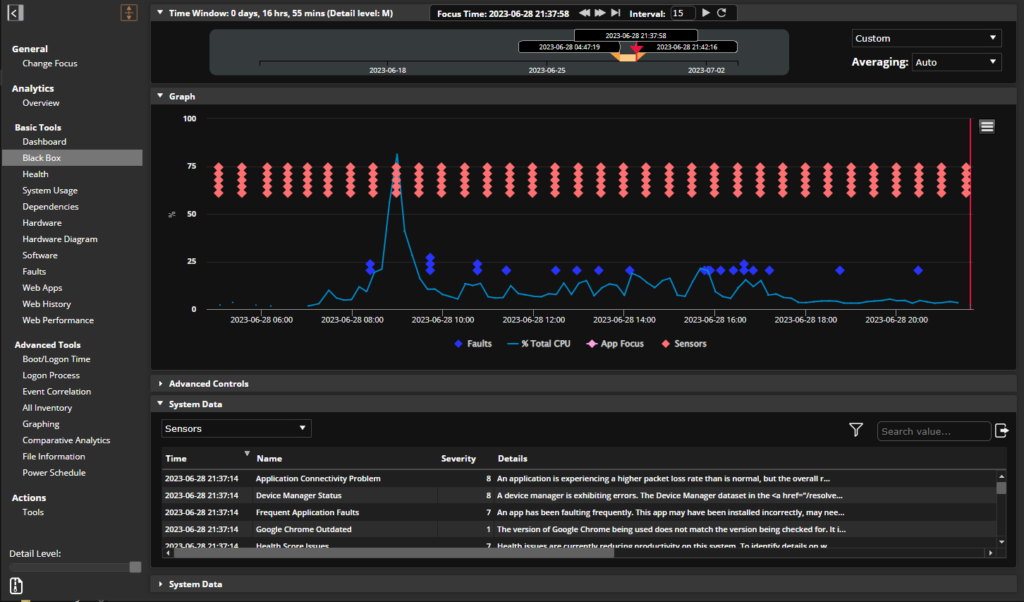
Reduce IT issues, improve employee engagement, and improve business outcomes with EUEM solutions
End-user experience monitoring (EUEM) is changing the way that organizations address IT issues to improve employee productivity and reduce costs. EUEM solutions track and measure the performance of applications and devices from the user’s point of view to ensure a smooth digital experience.
It’s a paradigm shift — from focusing on technical performance monitoring to managing user experience with workplace technology. The result is an IT department that takes a more proactive role rather than a reactive approach to IT issues.
End-User Digital Experience Matters
A key indication of the importance of digital experience to business efficiency comes from Forrester’s Employee Experience Index. According to Forrester, 30% of the factors influencing employee engagement are related to technology. Better interactions with workplace technology — for example, steady connection and fewer interruptions — help boost productivity and better meet business outcomes.
That’s why more organizations are realizing the value of investing in digital employee experience monitoring solutions. Those tools give visibility into the entire IT environment through the point of view of the end user. This perspective enables a holistic understanding of your workforce’s digital needs and technology pain points. IT teams can then make data-driven decisions to optimize resources better and increase help desk efficiency.
Productivity gains
Digital employee experience (DEX) has to do with the quality of employees’ interactions with the technology they need to do their jobs. DEX affects productivity because slow systems, crashing apps, and long help desk calls generate frustration. Those issues hinder employees’ ability to accomplish their tasks.
In Lakeside Software’s The Future of Digital Workplaces report, based on commissioned research from ESI ThoughtLab, employees cite the following consequences of a poor digital experience:
- Reduced team collaboration
- Difficulty completing some job aspects
- Missed deadlines
- Inability to meet customer needs
Experience monitoring solutions help organizations stay on top of IT issues such as slow internet connection and frozen screens, which often contribute to poor digital employee experience and lost productivity.
Lakeside’s Digital Experience Cloud — our suite of DEX-related applications powered by SysTrack and featuring an intelligent-edge architecture — enables large organizations to measure and quantify to which extent their employees’ digital experience impacts their productivity.
Business impact
Findings from Lakeside’s research on future digital workplaces also point to a correlation between digital experience and KPI metrics for business success. Surveyed C-level executives believe improvements to digital employee experience could reduce costs by more than 18.1% and increase revenues by 12.1%.
Enhanced digital experience leads to fewer help desk tickets, which represent an onerous cost for organizations. According to 61% of IT leaders interviewed in Lakeside’s study, their organizations’ internal cost per IT ticket ranges between $15.01 and $30. By cutting 10 tickets per week, these companies would be able to save from $7,805.20 to $15,600 per year — depending on their IT ticket cost.
EUEM Translates into Fewer IT Issues
From the perspective of 92% of the employees surveyed in Lakeside’s study, the technology-related issues they experienced could have been prevented or avoided.
That’s why deploying a digital monitoring solution can make the difference:
- While traditional IT tools track performance metrics from the perspective of technology, digital experience monitoring (DEM) — part of an overall digital experience management — collects data from the user’s point of view. This approach provides a more holistic picture of the entire IT environment.
- A rich repository of data gives the insights necessary to address productivity roadblocks. For example, it’s possible to identify app performance issues affecting all users on a specific system and then take proactive actions to resolve them. Early detection reduces support levels and mean time to resolution (MTTR).
Digital Experience Monitoring Enables Data-Driven Actions
An effective end-user monitoring strategy has a foundation in these three pillars:
Data collection
EUEM solutions can understand the full scope of employee digital experience. They are able to collect telemetry data and user feedback through an agent installed on each endpoint. In other words, they use both quantitative and qualitative methods to track digital experience. Forrester’s New Wave report on EUEM notes that leading vendors go beyond collecting telemetry metrics to try to understand human perception of digital experience.
Analysis and reporting
An important aspect of DEX monitoring tools is the ability to analyze both user and device performance data to generate actionable insights for IT teams. Lakeside’s intelligent-edge architecture, for example, is able to process high frequency and high fidelity data using artificial intelligence to assess performance and identify issues. Smart sensors bring attention to critical problems to be addressed in order to create greater impact.
Through effective root cause analysis (RCA), IT technicians can find and solve issues more quickly. RCA can also lead to the discovery of related problems to be proactively fixed – before they cause disruption to end-users.
Data-driven actions
Thanks to increased visibility, IT teams can also take proactive actions to optimize resource usage. For example, companies can right-size spending on application licenses according to user workstyles and needs. They can also make strategic decisions to upgrade hardware based on performance rather than the age or traditional three- to five-year refresh cycles. Automated issue resolution — one of the features of Lakeside’s Digital Experience Cloud platform — also contributes to higher IT efficiency.
Demand for EUEM Is on the Rise
There is a growing demand for end-user experience monitoring. Gartner predicts that, by 2025, 70% of digital business projects will have to report digital experience metrics, up from less than 15% today. Gartner’s Market Guide for Digital Experience Monitoring also indicates that digital transformation and new, flexible work arrangements are pushing the drive for EUEM solutions.
Digital transformation
Companies have long been pursuing digital transformation to keep their businesses competitive. These initiatives have driven the adoption of new technologies such as software as a service (SaaS) and cloud-based applications.
A global survey by McKinsey indicates that the pandemic has increased the rate of digitalization of internal operations by three to four years. This push for digital transformation adds complexity to IT environments, primarily through the adoption of new technologies that are harder to monitor with legacy systems.
Lakeside’s research suggests a connection between DEX and digital transformation. C-level executives, IT leadership, and employees all agree that their organizations need to improve digital employee experience for greater innovation.
Remote work trends
More and more corporations are adopting a hybrid model in which employees work remotely for part of the week. Forrester predicts that the number of employees working remotely will eventually settle in at 300% of pre-pandemic levels at the minimum.
The shift to remote work has also added complexity to digital workspaces. As McKinsey’s research indicates, remote forms of work during the pandemic have increased the investments in data security and migration to the cloud.
Higher adoption of cloud technology creates challenges due to potential risk for outages. A DEM solution becomes more crucial than ever.
Lakeside’s Digital Experience Cloud can maintain visibility into those environments, tracking how users interact with cloud-based applications and services in real time. Our solution is capable of detecting issues such as poor internet connection whether employees are working in the office or at a remote location. DEM tools also help companies manage data privacy and security more effectively.
Those are among the top challenges of working remotely, according to employees surveyed in Lakeside’s report:
- Data privacy and security issues (44%)
- Poor quality of internet connection (32%)
- Virtual private network (VPN) issues (32%)
- Lack of help desk responsiveness (25%)
Some of those technical difficulties could be easily solved with the right monitoring solution. More organizations are now starting to see the importance of a DEM strategy to enable a modern workforce and measure business impact. According to 90% of executive respondents in Lakeside’s research, DEX is now a priority post-pandemic.
Empower Your Workforce with a Better Digital Experience
Equipping your workforce with the tools they need to succeed is crucial to higher employee engagement and productivity. End-user experience monitoring solutions help build more efficient workspaces because they focus on unlocking outstanding digital experience for your team.
Subscribe to the Lakeside Newsletter
Receive platform tips, release updates, news and more



